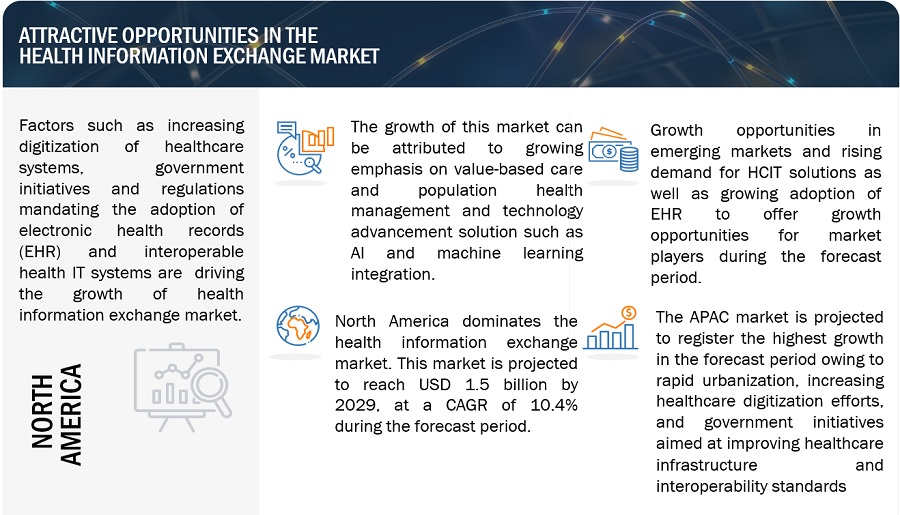The global Health Information Exchange market in terms of revenue was estimated to be worth $1.1 billion in 2020 and is poised to reach $2.0 billion by 2025, growing at a CAGR of 12.2% from 2020 to 2025 according to a latest report published by MarketsandMarkets™. Growth in this market is driven by factors such as the growing focus on patient-centric care delivery, the growing need to curtail healthcare costs, government initiatives for enhancing patient care and safety, and government funding for healthcare interoperability. On the other hand, factors such as lack of true interoperability solutions, lack of standards, data privacy and security concerns, the need for significant investments in infrastructure development and the use of outdated legacy systems are expected to restrict market growth to a certain extent in the coming years.
Download an Illustrative overview:

The growth in the Health Information Exchange market is driven by increasing demand for patient-centric care delivery, growing penetration of communication technologies in the healthcare system, real-time access to relevant patient data and government initiatives for enhancing patient safety and care. Moreover, the increasing government funding for healthcare interoperability is contributing to the market growth. However, data privacy concerns pose a challenge to the market growth.
Direct exchange segment accounted for the largest share of the global Health Information Exchange market in 2023.
On the basis type, the Health Information Exchange market is segmented into direct exchange, query-based exchange, and consumer mediated exchange segment. The direct exchange segment accounted for the largest share of the type segment in 2023 as this direct exchange type offers a straightforward and secure method for the electronic transmission of health information between different healthcare entities, including hospitals, clinics, laboratories, and pharmacies. Its simplicity in establishing point-to-point connections enables rapid data sharing without the need for intermediaries or complex infrastructure, thus reducing operational costs and streamlining workflow support the market growth.
By solution, platform centric solution segment to register the highest growth rate during the forecast period.
Based on solution, the Health Information Exchange market is segmented into portal centric solution, messaging centric solution and platform centric solution. The platform centric solution to register the high growth rate during forecast period due to their ability to offer comprehensive, integrated, and scalable solutions that address the evolving needs of healthcare organizations. Unlike traditional point-to-point exchange methods, platform-centric solutions serve as centralized hubs that facilitate the aggregation, normalization, and sharing of health data across multiple sources and systems. This centralized approach not only streamlines data exchange processes but also enhances data quality, governance, and analytics capabilities, enabling healthcare providers to derive actionable insights and improve patient outcomes.
Request for FREE Sample Pages:
Healthcare providers are the largest end users of the Health Information Exchange market
Based on end users, the Health Information Exchange market is segmented into healthcare providers, healthcare payers and other end users. The healthcare providers held the largest share among the end-users in 2023 due to their pivotal role as primary users and drivers of health data exchange solutions. In developed countries, such as the United States and several European nations, established healthcare systems and regulatory frameworks have fostered widespread adoption of HIE technologies among hospitals, clinics, and other healthcare facilities. Moreover, healthcare providers in developing countries are increasingly recognizing the value of HIE solutions in improving healthcare access, quality, and efficiency. For example, initiatives like the World Health Organization’s (WHO) Digital Health Atlas and the Global Digital Health Partnership are catalyzing the adoption of HIE technologies in low-resource settings by providing technical assistance, funding support, and knowledge sharing platforms. Recent instances from countries like India, Brazil, and Kenya highlight the growing momentum behind HIE implementations, driven by government mandates, public-private partnerships, and international aid programs aimed at strengthening health systems and achieving universal health coverage.
North America dominates the global Health Information Exchange market.
The Health Information Exchange market is segmented into five major regional segments, namely, North America, Europe, Asia Pacific, Latin America, and Middle East and Africa. In 2023, North America accounted for the largest share of the Health Information Exchange market. This region’s dominance is due to increasing integration of HIE software by hospitals, driven by regulatory mandates such as the Medicare and Medicaid EHR Incentive Programs (Meaningful Use) and the 21st Century Cures Act. For instance, the Office of the National Coordinator for Health Information Technology (ONC) reported that over 90% of non-federal acute care hospitals participated in some form of health information exchange as of 2022. This high adoption rate underscores the strategic importance of HIE solutions in achieving healthcare interoperability goals and improving care coordination.
Key Players
Prominent players in the Health Information Exchange market include Epic Systems Corporation. (US), Oracle (US), InterSystems Corporation (US), Veradigm LLC (US), Medical Information Technology, Inc. (US), HEALTH CATALYST, INC. (US), Chetu Inc. (US), Meditab (US), Siemens Healthineers (Germany), Deloitte (UK), Dreamsoft4u (US), NCrypted Technologies. (India), Glorium Technologies. (US), Daffodil Unthinkable Software Corporation (US), eClinicalWorks (US), NXGN Management, LLC. (US), Orion Health (New Zealand), Kellton (India), Telstra Health (Australia), CGI Inc. (Canada), Excelicare (US), Octal IT Solution. (US), Andersen (Poland), SISGAIN. (India), Cleverdev Software (US), OSP Labs (US)
